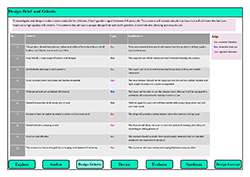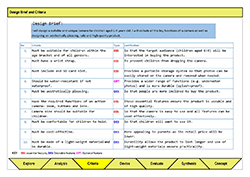T2: Design Brief & Design Criteria
You need to create a Design Brief and Design Criteria. They should be on the same page (400 Word Limit).
Design Brief
After you have analysed the problem you need to write a short, clear statement outlining what the problem is and what is required as a solution. This will be done in consultation with the Client, so you both agree on what needs to be done. It should: |

|
1) mention who the stakeholders are (Client, End Users etc.) and |

|
2) state what you intend to design. |
You MUST NOT use language that defines the solution at this stage e.g. I am going to design a square mahogany jewellery box with a hinged lid. This is far too defined and does not allow you to come up with a broad range of ideas and concepts.
Use language that is more open ended. e.g. I am going to design a product that can be used to store jewellery. |
This Template will help you to think about what you might want to include on this sheet.
You will not need to use all of them for every project. DO NOT copy the layout! |
Design Criteria
Your Design Criteria should be a list of what the design solution needs to do or include. The analysis you did earlier in the design process will help you to decide what needs to be included. The Design Criteria will be used to evaluate the effectiveness of your design ideas and the effectiveness of your final design (Concept Proposal). Some areas you might want to consider are listed below. The ones you need to consider will depend on the type of problem you are solving, so you will not necessarily have to use all of them for this project. |
Function |
What does the product have to do? |
Customer |
Who are you aiming this product at? (this is also known as the Target Market) Age, sex, social type (student, teenager, child, baby, professional, elderly, disabled) |
Aesthetics |
What does the design need to look like? How will colour, shape, tone, texture and layout affect the style of the design. Will the design be based on a theme? |
Materials |
What should it be made from? |
Environment |
Where will it be used? Is this important? (will it need to be waterproof, withstand high or low temperatures etc.) |
Ergonomics |
How can the product fit in with your target market's anthropometric data? How will the product fit in with human factors? |
Safety |
What factors need to be considered to make sure the product is safe to use? |
Environmental Issues |
What environmental impact could your design have? How can you minimise this? Can you use recycled material? Can it be re-used? Can the product have a secondary use? |
Cost |
How much should your product retail for? |
Social/Moral issues |
Is the product good for society to use? Will it make life easier for people or perhaps improve an existing product environmentally? Will the product offend anyone because of the graphical imagery? |
Recommended Criteria Table Headings
No |
Criteria |
Type |
Justification (Why?) |
1 |
Has to be eye catching |
Ess |
So that people will want to buy it. |
2 |
Flat pack to specific size |
Des |
So it is easier to store and transport |
3 |
Should be re-usable |
Opt |
Some people will prefer to purchase one that can be used more than once |
4 |
etc.. |
etc. |
etc. |
Key Ess: essential feature, Des: Desirable feature, Opt: Optional feature |
Examples of Design Brief & Criteria - DO NOT COPY!
 |
Design Brief & Criteria 133, 140, 147, 123, 146, 112, 148 |
|




